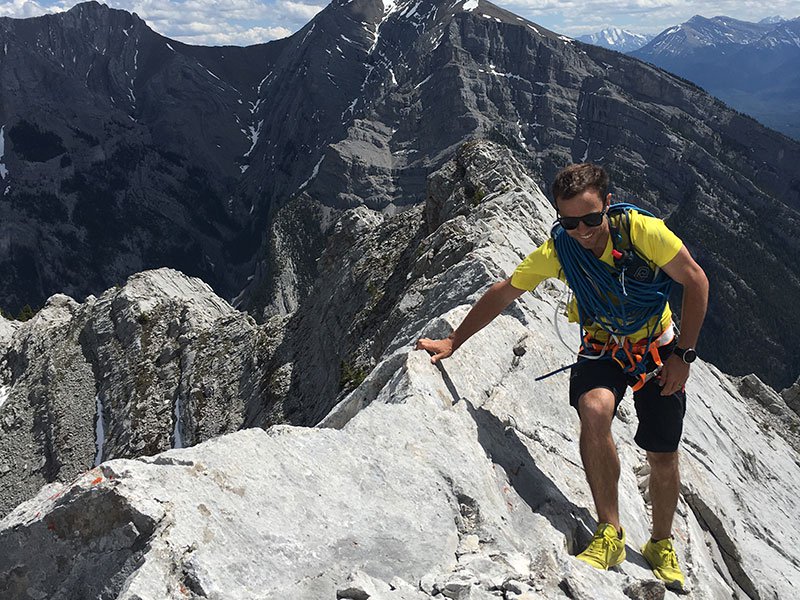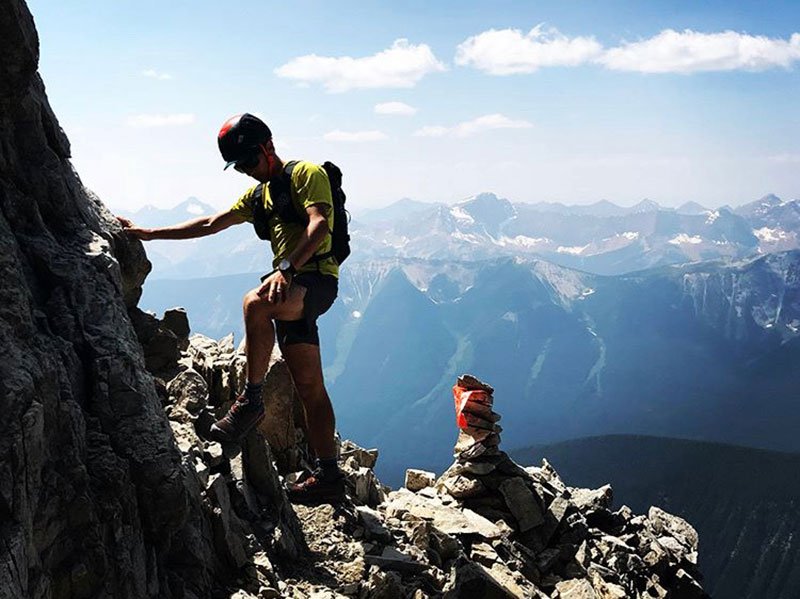Runner Adam Campbell’s Incredible Fall and Rewarding Recovery
In 2016, Adam Campbell, one of the top mountain ultrarunners in the world, was seriously injured during a 200’ fall while attempting the Horseshoe Traverse in the Canadian Rockies. Campbell had an inReach® satellite communicator with him that day, and, following his rescue, he faced months of difficult recovery. Campbell’s return to sport was documented in the short film, “In Constant Motion.” In his own words, he shared with Garmin the details of that fall and the journey to regain his strength.
On Aug. 31, I left the Illecillewaet campground in Rogers Pass, British Columbia — the birthplace of Canadian mountaineering — with 2 friends in order to attempt the Horseshoe Traverse. The traverse is an aesthetic 35-mile crescent-shaped alpine route that involves linking 14 peaks along beautiful knife-edge ridges, with glacier crossings, and up to mid fifth class scrambling and climbing. It includes the world-famous northeast ridge of Mount Sir Donald, one of the classic 50 climbs in North America and notably solid quartzite rock. It’s most definitely not a trail run. In fact, only the first couple and last couple of miles are on trails. The rest involves significant but obvious (if you stick religiously to the ridges) route finding.
Having spent time climbing, hiking, running and skiing in the Pass, I had been drawn to the line the moment I heard about it. The line combined elements of technical mountaineering, terrain you could move through quickly and a stunning setting. I had been eyeing the weather for a few weeks, waiting for the perfect weather window to attempt this very ambitious project. From what I could tell, the full traverse is not often climbed, and the fastest time that I had seen for the route was approximately 3.5 days. Having looked at the profile, I thought it was possible to complete the traverse in 24 hours for a team moving light and fast. Fortunately, 2 of the best partners for a project of this nature, Nick and Dakota, were just as keen on the mission as I was. We found ourselves in central British Columbia at the end of the summer, with the weather forecast showing at least 72 hours of perfectly blue skies, which we figured would give us a great buffer if things went south. We were all psyched.
We met in the campground the night before and meticulously packed the gear that we believed we needed for the route. This included a handful of climbing cams and nuts to build rappel anchors if we had to, 2 30-meter lengths of lightweight ropes, glacier harnesses, locking carabiners and belay devices, slings, lightweight crampons, ice axes, helmets, a puffy jacket, a windbreaker, a pair of gloves, a buff, an inReach satellite communicator, a cellphone, headlamps, spare batteries, an emergency bivy sack, a map and a bit of food and water.

As the sun rose, we ran up to the first peak along a well-defined trail that switchbacks up through dense, almost claustrophobic, old growth forest. After about 40 minutes of climbing, we popped up into the alpine, left the trail and began to make our way up the blocky terrain to the start of the ridge. The day was sunny and warm, with only a mild breeze rustling through our hair as we could see our intended route stretch out across the skyline in front of us.
We began to make our way quickly across the peaks. I was envious of the ease with which Nick and Dakota could move through this technical terrain. People who grow up in the mountains — like Nick and Dakota — have a different level of comfort and efficiency of movement in the alpine. I was rushing to keep up, my deeply competitive nature worrying that I was holding them back. They would scramble ahead to a peak or a col between rock outcroppings and wait patiently for me to catch up to them. The views were stunning, and I kept reminding myself that we had a very long day ahead of us. We made our way over the first 4 peaks quite quickly, and I was starting to plan ahead for the daunting ridge of Sir Donald that was only a couple of peaks away.
Nick and Dakota scampered up a near vertical but blocky feature called the Eisenhower Tower. It resembles a Lego tower with geometric shapes protruding out, making for excellent fourth-class scrambling. Nick, being the most competent climber amongst us, was working his way up an obvious weakness in the feature with Dakota close behind him and me in tow.

I was almost blindly trusting the route that he was choosing, not paying as much attention as I should, when I heard the most sickening sound any climber can imagine. I heard a loud crack and smelled an almost sulfurous smell as I felt a fridge-sized rock shift under my gentle grasp. The rock pulled loose onto me, and I instantly felt myself falling backward. I began tumbling and bouncing down a series of steep rocky ledges. I stayed conscious the whole time, and I remember a strange calm coming over me. There was a certainty and an inevitability that I was going to die, felt in that moment, and…
